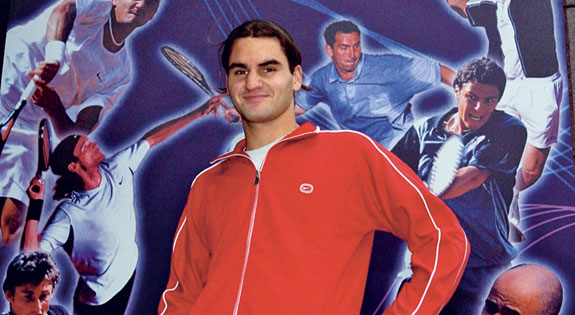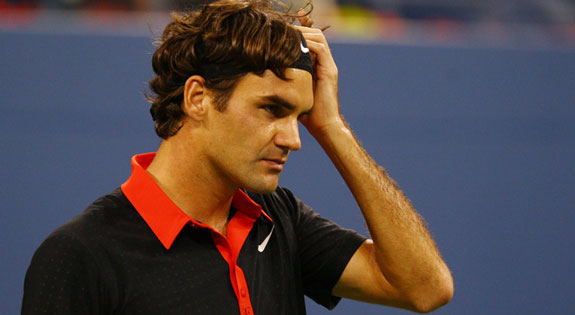
Roger Federer is playing in the ATP World Tour’s season-ending championship for an eighth time in 2009 at the O2 Arena in London. It was in 2002 when Federer first qualified for the ATP World Tour finale as a xx-year-old. Rene Stauffer, the respected Swiss tennis writer, chronicles Federer’s first appearance at the ATP World Tour Finals in this excerpt from his book THE ROGER FEDERER STORY, QUEST FOR PERFECTION ($24.95, New Chapter Press, www.RogerFedererBook.com). This chapter, chapter No. 14, is called “Red Dawn In China.”
Roger Federer’s title in Vienna represented a big step towards qualifying for the Tennis Masters Cup in China. Federer passed Albert Costa, Andy Roddick and Tommy Haas in Champions Race to rank No. 7 after his victory along the banks of the Danube. His ATP ranking, based on the 52-week results, also rose to a career-high No. 7—the career-high ranking that his countryman Jakob Hlasek achieved in 1989. After a quarterfinal finish at the Tennis Masters Series event in Madrid, Federer moved to No. 6 in the rankings—marking the highest ATP ranking ever achieved by a Swiss player. His trip to China was well within reach, but now he wanted to finally win “his” tournament—the Swiss Indoors in Basel. After finishing runner-up the last two years, Federer seemed poised to finally capture his hometown tournament. In the quarterfinals, Federer faced Roddick for the first time in his career and defeated the 19-year-old American 7-6 (5), 6-1 in an exciting match that lasted until midnight. In the semifinals, the brawny David Nalbandian, Federer’s rival from junior days, spoiled Roger’s hometown title dreams, winning a 6-7 (2), 7-5, 6-3 decision after trailing 7-6, 3-1.
The final ATP event of the year is the Tennis Masters Series in Paris, played at the Palais Omnisports de Paris-Bercy, a majestic entertainment arena located on the north bank of the Seine featuring manicured grass-covered sides on its outside walls. The event usually decides the final qualifiers for the year-end Tennis Masters Cup and 2002 was no different. Federer officially booked his ticket for Shanghai when Tim Henman lost in the third round to Nicolas Escude and Federer straight-setted Tommy Haas to reach the quarterfinals. With his goal achieved, Federer’s quarterfinal with Hewitt lacked the tension of his previous matches, and he lost to the world No. 1 in straight sets.
Federer traveled to Shanghai in November of 2002 as the No. 6 ranked player in the world. At age 21, he was the youngest player in the Tennis Masters Cup field, had nothing to lose as a first-time qualifier and therefore, he was duly relaxed during the event. “Everything after this will be an encore,” he said. The Tennis Masters Cup took place in one of five gigantic exhibition halls that were reminiscent of airplane hangars in the Pudong district of Shanghai, a faceless area between the airport and downtown.
For Federer, his trip to the Tennis Masters Cup in China was unique. “This is no ordinary tournament; it’s an adventure,” he said juggling tennis balls in front of his hotel and parading up and down along the edge of a four-lane main road in a publicity photo shoot for photographers. He was playing in the Far East for the first time and immediately felt comfortable in his new surroundings. He enjoyed the unique atmosphere of the 11,500 square meter Expo-Hall, whose 10,000 spectators turned the place into an electric atmosphere.
The Tennis Masters Cup was the biggest, the most expensive and the most widely-covered professional sports event in China at the time. For most Chinese, tennis was relatively unknown. It was an undiscovered sport that they didn’t yet really understand. Whenever players double-faulted, the spectators would scream. Enthusiastic Chinese journalists would pose the strangest questions in press conferences. “Why are you always smiling, Mistel Fedelel? Because you are in such good shape?” a Chinese reporter asked Federer in broken English. Following another match, French Open Champion Albert Costa was asked by a Chinese scribe, “You always used to eat bananas when changing sides. Why not today? Perhaps because you don’t like Chinese bananas?”
Federer, the Masters rookie who came to China with his mother Lynette and girlfriend Mirka, basked in the preferential treatment accorded to each of the eight participants. “I feel special here with the entire hullabaloo and the many body guards,” he said. “They read your every desire from your lips. It’s fortunate that there are so few players here.” At Shanghai, it became even more clear that Federer possessed a certain star quality and that he wasn’t blinded by the limelight. He loved the attention and flourished in it.
The Tennis Masters Cup is a round-robin event with the eight qualifying players paired in two round-robin groups of four. In his group, Federer ranked Andre Agassi as the favorite and himself and Juan Carlos Ferrero of Spain as the leading contenders for the No. 2 position. Federer’s assessment quickly proved to be wrong. Federer beat Ferrero in his opening round-robin match and then defeated Jiri Novak for a 2-0 round robin record. Federer then clinched his round-robin flight when Agassi lost to both Novak and Ferrero. No longer with a chance of making the semifinals, Agassi hastily left China in disappointment, using a hip injury as the reason for his withdrawal.
In the semifinals, Federer faced Hewitt, who already clinched the year-end No. 1 ranking for a second year in a row. The Australian barely qualified for the semifinals and benefited from Carlos Moya winning a three-hour meaningless match over fellow Spaniard Costa, where a Costa victory would have him reach the semifinals rather than Hewitt. Although Federer lost five of the last seven matches with Hewitt, he reasoned his chances of beating him and winning the first big championship of his career were very attainable.
Federer started his semifinal with Hewitt in furious fashion, taking a 3-0 and a 5-2 first-set lead, but Hewitt ran and fought as if his life were at stake. Hewitt fought off five set points and rallied for a 6-5 lead. Serving for the set, Hewitt staved off another five break points, before capturing the first set 7-5. Federer, however, was not ready to surrender. The second set turned into a wild back-and-forth struggle. Hewitt served for the match at 5-4 and held match point, but Federer broke back for 5-5. After holding serve for 6-5, Federer evened the match by breaking Hewitt’s serve, connecting on his fourth set point of the game.
The Chinese fans went wild—out of their seats, screaming and cheering. In the commentary booth high above the stadium, Heinz Günthardt and Stefan Bürer, the Swiss TV commentary team, described the tension and fast-paced action to the audience back in Switzerland, where it was Saturday morning and many people postponed their weekend shopping to watch the dramatic match with their new sports hero.
As the match extended into a third hour, the breaks seemed to fall in favor of Federer. Leading 4-3 in the final set, Federer held two break points to put him in the position to serve for the match. Both opportunities, however, were lost and Hewitt held for 4-4. Hewitt then subsequently broke Federer’s serve the next game to serve for the match at 5-4. The Australian reached his second match point—and shockingly double-faulted. Federer then broke Hewitt’s serve to square the match at 5-5. Serving with new balls in the next game, Federer committed two consecutive double-faults to allow Hewitt to break him back and gained another opportunity to serve for the match. It took Hewitt another four match points before he finally corralled Federer and advanced to the final with an epic 7-5, 5-7, 7-5 victory. Following the match, Hall of Fame journalist Bud Collins walked into the press room and asked his fellow scribes, “Have you ever seen a better match?”
In the craziest match of his career to date, Federer was aware that he let victory escape from his grasp. “I have no one to blame but myself,” he said to a small group of Swiss journalists who traveled to China. “Luck wasn’t on my side. I blew a big opportunity. That hurts.” A vacation in Phuket, Thailand helped heal the wounds.

